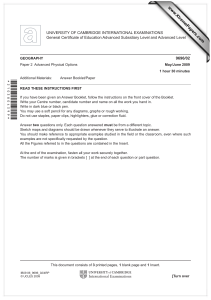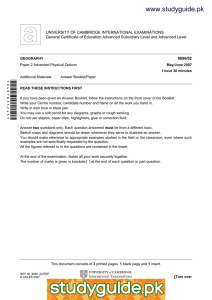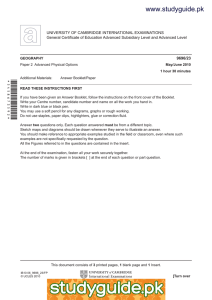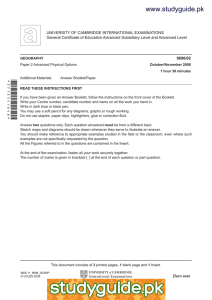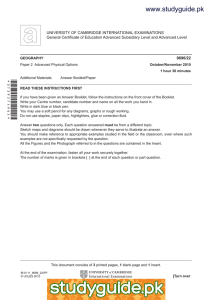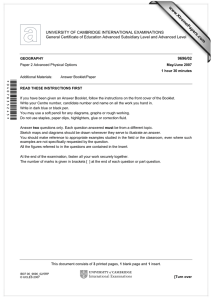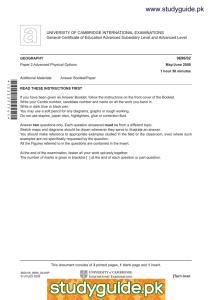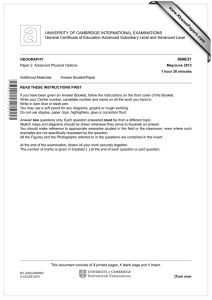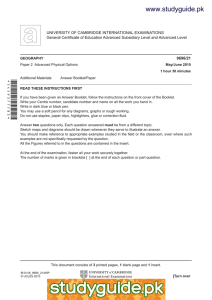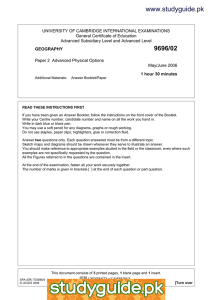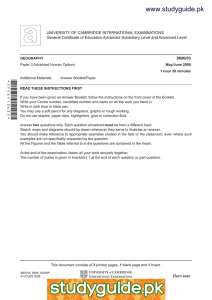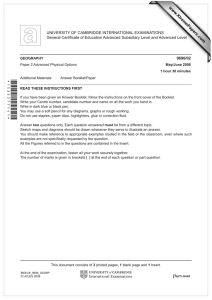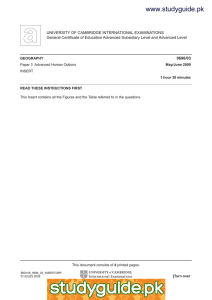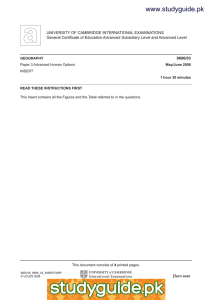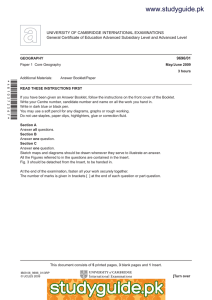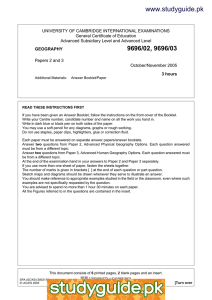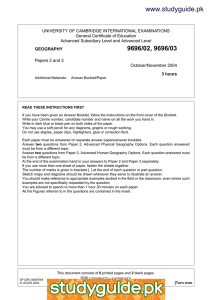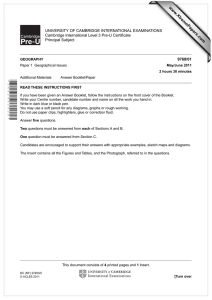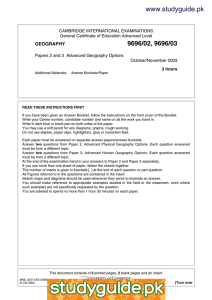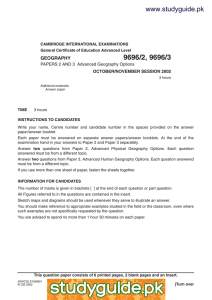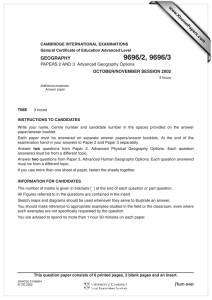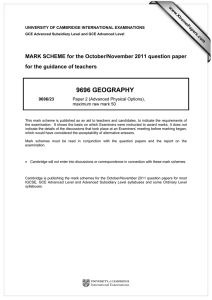www.studyguide.pk
advertisement
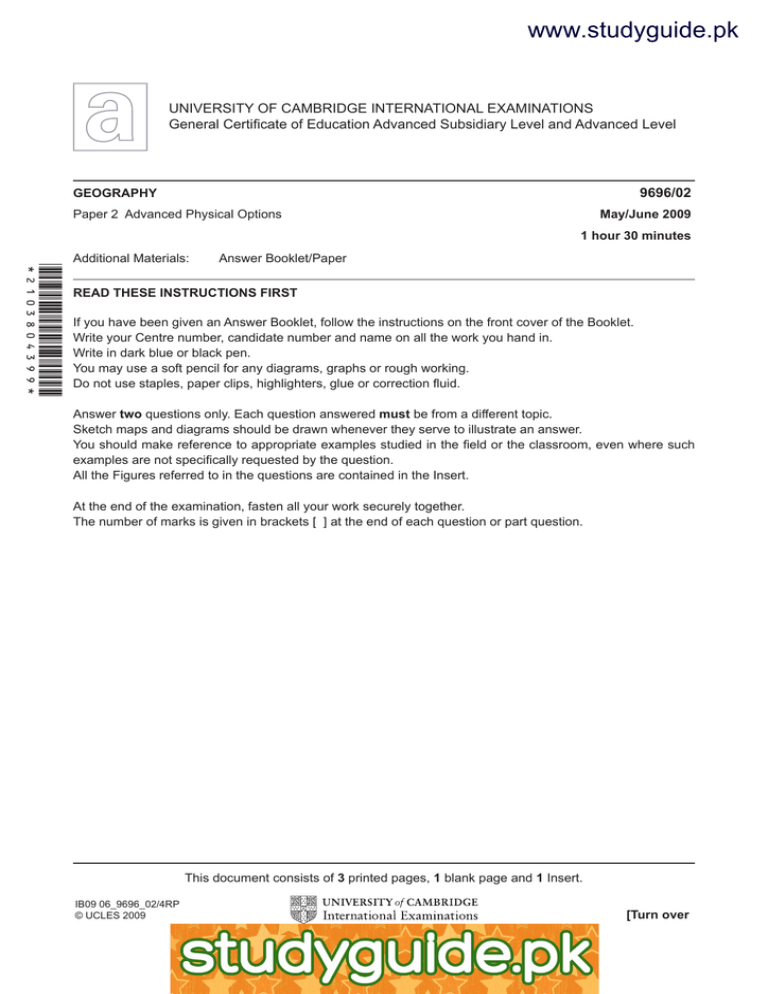
www.studyguide.pk UNIVERSITY OF CAMBRIDGE INTERNATIONAL EXAMINATIONS General Certificate of Education Advanced Subsidiary Level and Advanced Level 9696/02 GEOGRAPHY Paper 2 Advanced Physical Options May/June 2009 1 hour 30 minutes *2103804399* Additional Materials: Answer Booklet/Paper READ THESE INSTRUCTIONS FIRST If you have been given an Answer Booklet, follow the instructions on the front cover of the Booklet. Write your Centre number, candidate number and name on all the work you hand in. Write in dark blue or black pen. You may use a soft pencil for any diagrams, graphs or rough working. Do not use staples, paper clips, highlighters, glue or correction fluid. Answer two questions only. Each question answered must be from a different topic. Sketch maps and diagrams should be drawn whenever they serve to illustrate an answer. You should make reference to appropriate examples studied in the field or the classroom, even where such examples are not specifically requested by the question. All the Figures referred to in the questions are contained in the Insert. At the end of the examination, fasten all your work securely together. The number of marks is given in brackets [ ] at the end of each question or part question. This document consists of 3 printed pages, 1 blank page and 1 Insert. IB09 06_9696_02/4RP © UCLES 2009 [Turn over www.xtremepapers.net 2 www.studyguide.pk Tropical Environments Only one question may be answered from this topic. 1 (a) Describe and explain the differences between the climates of the humid tropics and the seasonally humid (sub-humid) tropics. [10] (b) To what extent can the landforms found in the humid and the seasonally humid (sub-humid) tropics be explained by present-day weathering processes? [15] 2 (a) Fig. 1 shows the movement of nutrients through the tropical rainforest ecosystem. Using the diagram, explain how nutrients are introduced, transferred, stored and lost from the ecosystem. [10] (b) For either the tropical rainforest or the savanna ecosystem, explain the extent to which soils may affect sustainable management. [15] Coastal Environments Only one question may be answered from this topic. 3 (a) How might changes in sea level affect the formation and variety of coral reefs? [10] (b) To what extent is the building of sea defences (hard engineering) a more effective method of sustainable management than allowing coasts to revert to a natural state (managed retreat)? [15] 4 (a) Fig. 2 shows some factors influencing wave formation. Using Fig. 2, describe how wind and fetch affect wave height and suggest other factors which might affect the form of a wave. [10] (b) How does wave action contribute to both erosion and deposition on coasts? © UCLES 2009 9696/02/M/J/09 www.xtremepapers.net [15] 3 www.studyguide.pk Hazardous Environments Only one question may be answered from this topic 5 (a) Why may tectonic plate margins produce hazardous environments? [10] (b) To what extent can the effects of hazards associated with tectonic plate margins be managed? [15] 6 (a) Fig. 3 shows the positions of a hurricane (tropical storm) as it approached the coast of the USA. Describe the course taken by the hurricane and suggest reasons why it was difficult to predict where the hurricane would strike the coast. [10] (b) Explain which areas of the world are most at risk from hurricanes (tropical storms) and the effects such storms can have upon populated areas. [15] Arid and semi-arid environments Only one question may be answered from this topic. 7 (a) Explain how wind may erode and transport material in hot deserts. [10] (b) To what extent are the landforms of hot deserts the product of both wind and water action? [15] 8 (a) Fig. 4 shows the distribution of hot arid and semi-arid climates. Describe and explain the locational pattern of areas with hot arid and semi-arid climates. [10] (b) Explain how soils are affected by and vegetation is adapted to hot desert conditions. © UCLES 2009 9696/02/M/J/09 www.xtremepapers.net [15] [Turn over www.studyguide.pk 4 BLANK PAGE Copyright Acknowledgements: Question 2 Fig. 1 Question 8 Fig. 4 © Reading, Thompson & Mollington, Humid Tropical Environments, p.165. Blackwells, 1995. © Skinner & Porter, The Dynamic Earth, p.357. John Wiley & Sons Ltd. 2000. This material is reproduced with permission of John Wiley & Sons, Inc. Permission to reproduce items where third-party owned material protected by copyright is included has been sought and cleared where possible. Every reasonable effort has been made by the publisher (UCLES) to trace copyright holders, but if any items requiring clearance have unwittingly been included, the publisher will be pleased to make amends at the earliest possible opportunity. University of Cambridge International Examinations is part of the Cambridge Assessment Group. Cambridge Assessment is the brand name of University of Cambridge Local Examinations Syndicate (UCLES), which is itself a department of the University of Cambridge. 9696/02/M/J/09 www.xtremepapers.net
